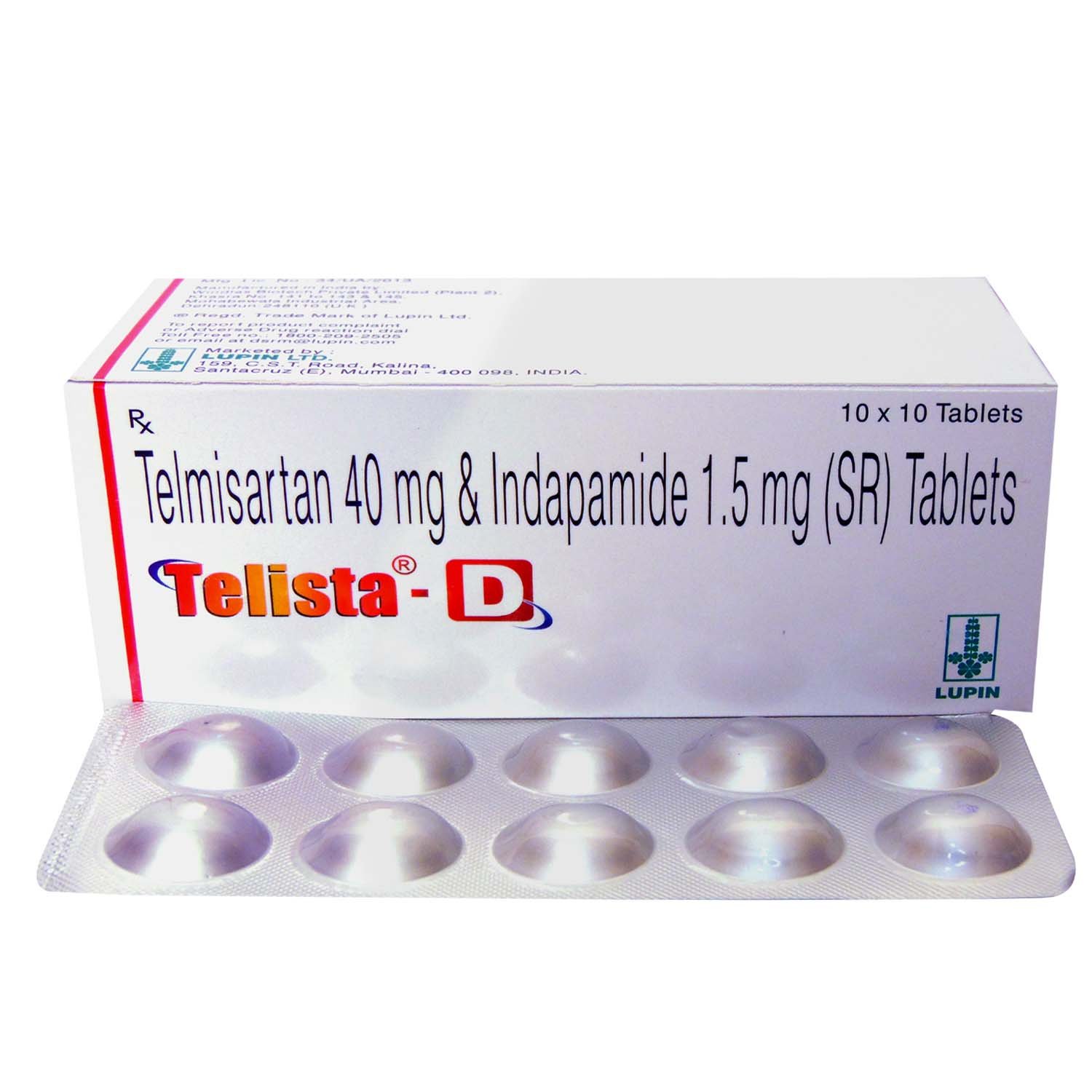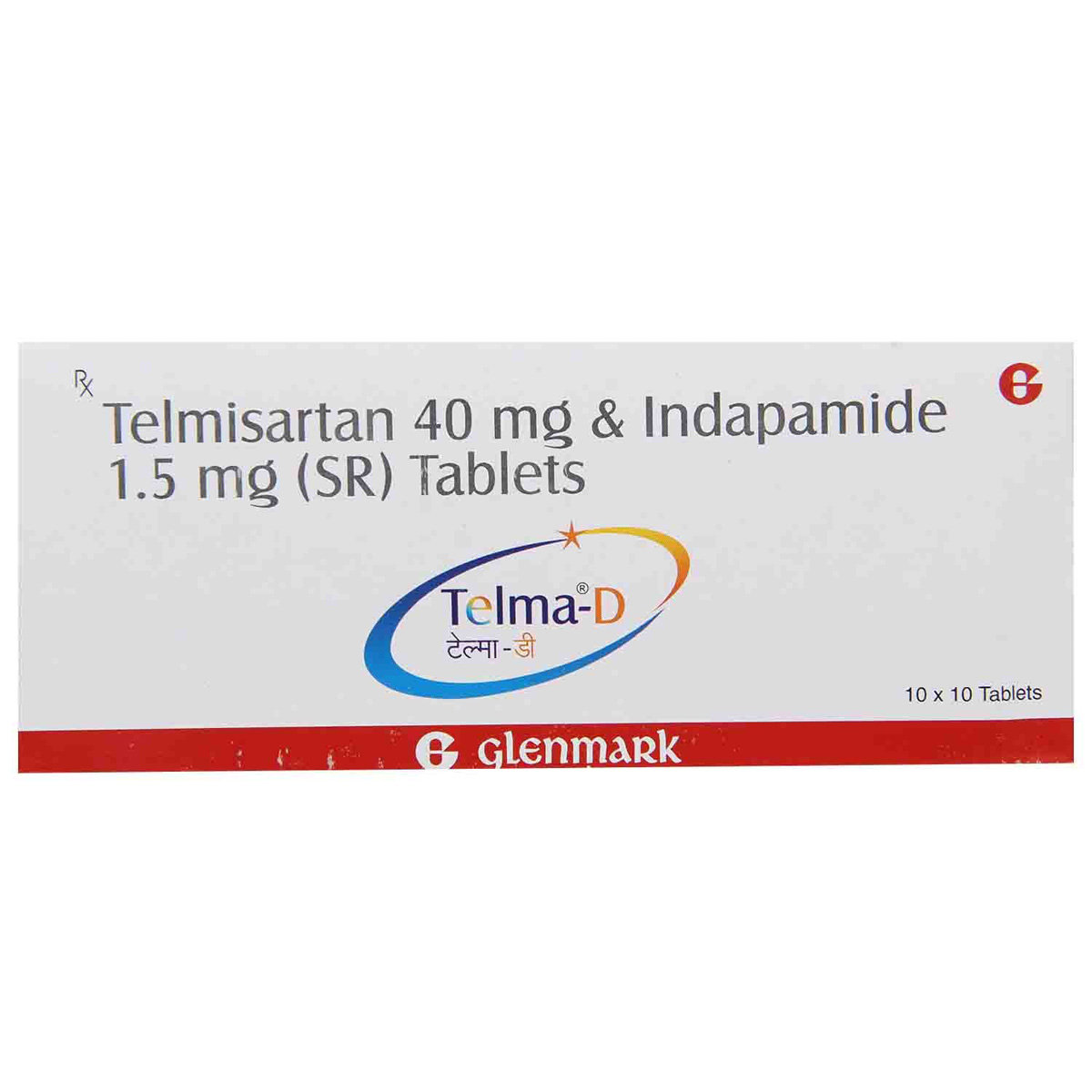Telista D Tablet 10's
MRP ₹165.5
(Inclusive of all Taxes)
₹24.8 Cashback (15%)
Provide Delivery Location
Online payment accepted
 Prescription drug
Prescription drugWhats That
 46 people bought
46 people bought Composition :
Manufacturer/Marketer :
Consume Type :
Expires on or after :
Return Policy :
About Telista D Tablet
Telista D Tablet belongs to the class of anti-hypertensives primarily taken to treat hypertension (high blood pressure). Hypertension or high blood pressure is a life-long or chronic condition in which the blood pressure against the artery wall becomes too high. It can lead to the risk of heart diseases, like heart attack and stroke.
Telista D Tablet is a combination of Telmisartan (angiotensin II receptor antagonist) and Indapamide (diuretic or water pill). Telmisartan is an angiotensin receptor blocker that helps to relax and widen the blood vessels (arteries). Indapamide is a diuretic that removes extra water and several electrolytes from the body. It also relaxes blood vessels and enhances blood flow. Together it lowers blood pressure and prevents the risk of stroke, heart attack and oedema (fluid retention).
Take Telista D Tablet as prescribed by your doctor. You are advised to take Telista D Tablet for as long as your doctor has prescribed it for you depending on your medical conditions. You may experience nausea, diarrhoea, stomach pain, constipation, infection, headache, dizziness, back pain, inflammation of the nose, chest pain, weakness, indigestion, hypertonia (increased muscle tone), nervousness, peripheral oedema, sore throat, cough, conjunctivitis (inflammation in the eyeball), sinus inflammation. Most of these side effects of Telista D Tablet do not require medical attention and gradually resolve over time. However, if the side effects are persistent, reach out to your doctor.
Do not use potassium supplements or salt substitutes unless the doctor has told you. In rare cases, Telista D Tablet can cause a condition that results in the skeletal muscle problem, leading to further kidney failure. If you notice unexplained muscle pain, dark colour urine, tenderness or weakness, especially if you also have a fever or unexplained tiredness, immediately contact the doctor. If you have diabetes, do not use Telista D Tablet with any medication that contains aliskiren (a blood pressure medicine). Before taking Telista D Tablet , tell your doctor if you have ever had liver disease, kidney failure, glaucoma, high or low levels of magnesium or potassium in your blood, have allergies or asthma, lupus (an autoimmune disease), diabetes or an allergy to penicillin or sulfa drugs.
Uses of Telista D Tablet
Directions for Use
Key Benefits
Telista D Tablet belongs to the class of anti-hypertensives primarily taken to treat hypertension (high blood pressure). Telista D Tablet is a combination of Telmisartan (angiotensin II receptor antagonist) and Indapamide (diuretic or water pill). Telmisartan is an angiotensin receptor blocker that helps to relax and widen the blood vessels (arteries). Indapamide is a diuretic that removes extra water and several electrolytes from the body. It also relaxes blood vessels and enhances blood flow. Together it lowers blood pressure and prevents the risk of stroke, heart attack and oedema (fluid retention).
Storage
Drug Warnings
Telista D Tablet should not be given to the people allergic to Telista D Tablet or any of its ingredients, have low blood pressure (less than 90 mm of Hg), have had a heart attack, kidney disease, liver disease, pregnant women, or planning to get pregnant and breastfeeding women. It should be used with caution in patients who have diabetes. Besides this, it is contraindicated in low blood pressure (hypotension), cardiogenic shock (sudden stopping of blood flow to the heart) and aortic stenosis (heart valve problem). Telista D Tablet can pass into breast milk, so before starting Telista D Tablet , either you need to stop nursing or you should not take Telista D Tablet while breastfeeding. If you have anuria (non-passage of urine), please do not take Telista D Tablet as it is contra-indicated in it and may lead to further complications.
Diet & Lifestyle Advise
- Keep your weight under control with BMI 19.5-24.9.
- Do regular physical activity or exercise for at least 150 minutes per week, or about 30 minutes most days of the week. Doing this can help you to lower your raised blood pressure by about 5 mm of Hg.
- Limit intake of sodium chloride (table salt) in your daily diet to 2300 mg per day or less than 1500 mg is ideal for most adults.
- If you are taking alcohol, then only one serving for women and two servings for men is advisable.
- Quitting smoking is the best strategy to lower the risk of heart disease.
- Avoid chronic stress as it can raise your blood pressure. Try to enjoy and spent time with your loved ones to cope with stress and practice mindfulness techniques.
- Monitor your blood pressure daily and if there is too much fluctuation, then immediately contact your doctor.
- Try to include heart-healthy omega 3 fatty acids containing food drinks in your daily diet. You can also use low-fat cooking oil like olive oil, soybean oil, canola oil, and coconut oil to lower your elevated blood pressure.
Side Effects of Telista D Tablet
- Nausea
- Diarrhoea
- Stomach pain
- Constipation
- Infection
- Headache
- Dizziness
- Back pain
- Inflammation of the nose
- Chest pain
- Weakness
- Indigestion
- Nervousness
- Peripheral oedema
- Sore throat
- Cough
Habit Forming
Therapeutic Class
All Substitutes & Brand Comparisons
RX
Out of StockIndipil T Tablet 10's
Eris Life Sciences Ltd
₹139
(₹13.9 per unit)
6% CHEAPERRX
Telma D Tablet 10's
Glenmark Pharmaceuticals Ltd
₹163
(₹14.67 per unit)
1% CHEAPER
FAQs
Drug-Drug Interactions Checker List
- ALISKIREN
- AMIODARONE
- ACARBOSE
- PHENYLEPHRINE
- DEXTROMETHORPHAN
- PARACETAMOL
Special Advise
- Regularly monitor blood pressure levels to prevent hypotension (low blood pressure).
- Get up slowly while rising from lying or sitting position as Telista D Tablet may cause dizziness.
- Your doctor may advice regular monitoring of electrolyte, as Telista D Tablet may cause fluctuations in electrolytes.
Disease/Condition Glossary
Hypertension: It is a chronic condition when blood pressure is too high. This condition can lead to hardened arteries (blood vessels), decreasing the blood and oxygen flow to the heart. Blood pressure is the measurement of the force that our heart uses to pump blood to all parts of the body. Raised blood pressure can cause chest pain (angina) and heart attack (when blood supply to the heart is blocked). Additionally, high blood pressure also causes brain damage (stroke) and kidney failure. High blood pressure can be diagnosed with the help of a blood pressure monitor or sphygmomanometer. Systolic pressure is the pressure when the heart pumps blood out. On the other hand, diastolic pressure is when your heart is at the resting stage between heartbeats. If your blood pressure is 140/90 mm of Hg, it means the systolic pressure is 140 mm of Hg, and diastolic pressure is 90 mm of Hg. Ideal blood pressure should be between 90/60 mm of Hg and 120/80 mm of Hg.

Have a query?
Alcohol
Safe if prescribed
You are recommended not to consume alcohol and Telista D Tablet to avoid unpleasant side effects like drowsiness, dizziness, and liver damage.
Pregnancy
Consult your doctor
Telista D Tablet may cause fetal damage and can affect the unborn baby (fetus). Please consult your doctor before taking Telista D Tablet if you are pregnant or planning to conceive
Breast Feeding
Consult your doctor
Telista D Tablet is known to pass breast milk, but, its effect on the baby is not known. So, before breastfeeding, let your doctor know about this.
Driving
Safe if prescribed
Drive with caution, Telista D Tablet usually causes dizziness and affects driving ability.
Liver
Consult your doctor
Please take Telista D Tablet only with the doctor's advice if you have a history of liver diseases/conditions
Kidney
Consult your doctor
Let your doctor know if you have any history of kidney diseases or impairment before taking Telista D Tablet .
Children
Safe if prescribed
Telista D Tablet is not recommended in children younger than 18 years of age.
Recommended for a 30-day course: 3 Strips











